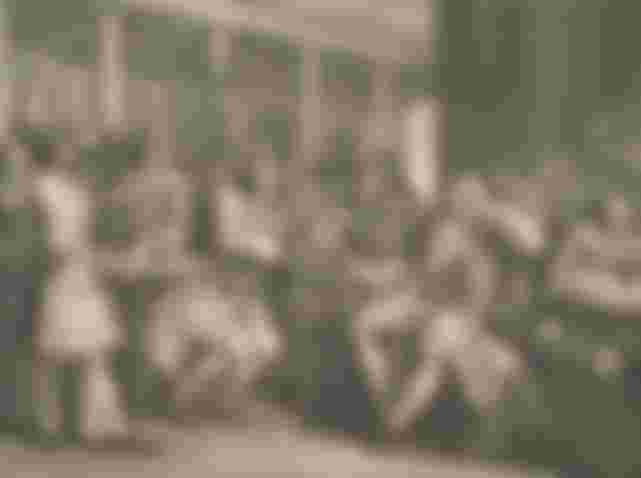"No body, no murder"

On 16 August 1660, local businessman William Harrison left his home in Chipping Campden to collect some rent from neighbouring farms. When he failed to return home that night, his son Edward and a manservant named John Perry set out to find him. On the route they expected William to have taken, the two discovered some personal items and clothing belonging to the missing man; some were covered in blood. An investigation took place; the manservant John Perry was arrested the following week and initially blamed his own mother Joan and brother Richard for the murder. Eventually the three all stood trial for the killing of Harrison, though Harrison’s body was never recovered. All three were found guilty in March 1661 and hanged.
A year after the executions, the ‘victim’ of this horrendous crime returned to the village, in full health and with an incredible story. William Harrison informed the authorities that on the night in question, he had been violently abducted by several men and taken to the port of Deal in Kent, where he was bundled onto a Turkish ship and later sold as a slave. Following the death of his elderly master, he managed to escape and concealed himself on board a Portuguese ship and travelled to Dover.
At the time, at least, it appears that no one had any doubts about Harrison’s story, though following this incredible miscarriage of justice resulting in the execution of three innocent people, courts in Britain would follow a principle of ‘no body, no charge of murder’ for almost the next three centuries.
The principle was maintained well into the 20th century, when advances in forensic science in such cases as George Haigh – the ‘Acid Bath Murderer’ who killed at least six people in the 1940s and dissolved the bodies in acid, proved beyond doubt that murder had taken place, without the need for a body to be presented as evidence.
The use of fingerprints
The first criminal conviction which used a fingerprint as prime evidence was the case of habitual thief Harry Jackson in September 1902.

One of the burglaries leading up to Jackson’s arrest had occurred at 156 Denmark Hill, which was the home of a family called Tustin. Jackson had gained entry through a ground-floor window and had stolen a number of ivory snooker balls. Whilst doing so, he had left a fingerprint on a recently painted windowsill. The fingerprint was examined by officers from the fingerprint bureau and positively matched to Jackson.
When the case was tried at the Central Criminal Court Old Bailey, Jackson pleaded not guilty. The whole case rested on one fingerprint which placed the defendant at the scene of the crime. The evidence was strongly tested by the court, with officers from the fingerprint bureau giving expert testimonies. The judge and jury accepted the validity of the evidence and convicted Harry Jackson.
However, many contemporary commentators still doubted the new crime-fighting revelation. One writer wrote to The Times, commenting that:
“Scotland Yard, once known as the world’s finest police organisation, will be the laughing stock of Europe if it insists in trying to trace criminals by odd ridges on the skin.”
The first arrest for drink-driving

At 12.45am on 10 September 1897, a London police officer named PC Russell observed a licenced cab driver driving his cab erratically along New Bond Street in London. The 25-year-old driver George Smith reportedly swerved from one side of the road to the other, before running across the footway and crashing into number 165, breaking a water pipe and causing damage to the property’s front window. PC Russell approached Smith, realised that he had been drinking and escorted him to Vine Street police station, Westminster, Smith was examined by a local police surgeon who confirmed his drunken state and that he should not have been in charge of his vehicle.
Smith was charged and appeared in front of the magistrate at Marlborough Street police court later that same morning. When questioned by PC Russell in front of the bench, he admitted that he had consumed several glasses of beer.
The magistrate sentenced Smith to a fine of 20 shillings and advised the cabbie:
“You motor-car drivers ought to be very careful, for if anything happens to you – well, the police have a very happy knack of stopping a runaway horse, but to stop a motor is a very different thing.”
The 999 emergency service
“Only dial 999 if the matter is urgent; if, for instance, the man in the flat next to yours is murdering his wife or you have seen a heavily masked cat burglar peering around the stack pipe of the local bank building… If the matter is less urgent, if you have merely lost little Towser or a lorry has come to rest in your front garden, just call up the local police.”

During the early hours of 7 July 1937, architect John Stanley Beard of Hampstead in north London had been awoken by a noise outside his bedroom window. As he peered out he saw a would-be intruder, later identified as Thomas Duffy. Beard’s quick-thinking wife dialled 999 and gave a description of the suspect and the direction in which he had escaped. The police acted quickly and arrested Duffy nearby; he was charged and convicted of attempted breaking and entering. Mr Beard was delighted with the result and commented after the event that: “It struck me, as a householder and fairly large taxpayer, that we are getting something for our money and I was very impressed by it.”
During the first week of the 999 launch, police received 1,336 calls – 91 of which were pranks.
Today the 999 system receives more than 30 million calls a year.
The use of footprints

Sydney Malkin was a 47-year-old chef who had a penchant for women’s underwear. In 1956, he broke into the Hastings flat of one Mrs Edith Bowles and stole items of underwear and a silk slip. Mrs Bowles, whose flat was on an upper level, had left her underwear out to dry with the windows open. Mrs Bowles reported the crime to a local police officer, PC Ernest Parker. Parker examined the point of entry and was astonished to discover a number of bare footprints – one on top of the television, one on a loudspeaker and finally one on the floor.
The unusual modus operandi – stealing women’s underwear from high-rise flats – matched the profile of Sydney Malkin. He was arrested and comparisons were examined between the footprints left at the crime scene and impressions taken of Malkin’s feet – they were identical. Fingerprint expert Detective Superintendent Holten from Scotland Yard presented his findings to the magistrates at Hastings. Malkin was convicted – the first case of its kind in England – and bound over to keep the peace for three years.





I love detective stuff XD And its funny how they thought fingerprints were gimmicky. The story of how the use of fingerprints started in America was funnier.